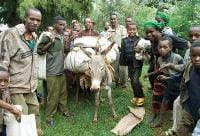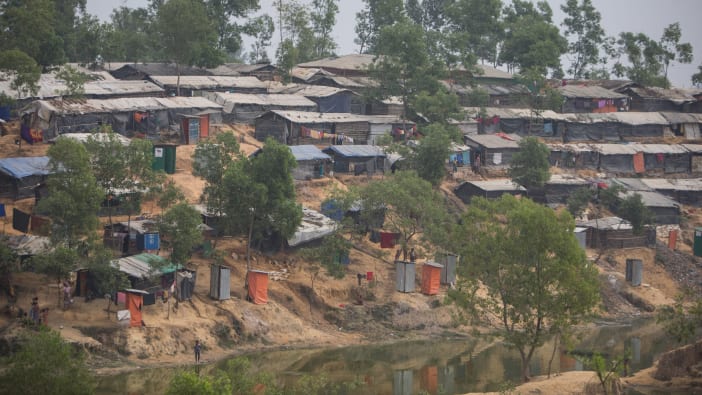Many millions of people around the world depend on livestock to support their families. These livestock can be the cattle, camels, sheep and goats that make up the pastoralist herds in sub-Saharan Africa, or the water buffalo that provide milk and draught power in many parts of Asia, or the llamas whose meat and hair are a key source of family income in Peru.
As discussed in the last edition of Footsteps, disasters are a part of everyday life for a large part of the world’s population. These disasters include droughts, floods, earthquakes, tsunamis, tropical storms and severe winters. In many cases, not only are the people affected by the disaster, but their livestock are too. Animals may die in droughts and floods, lose their shelter or their source of fodder in earthquakes, or their water source may be contaminated in tropical storms. Disasters can therefore have an impact on people’s livelihoods, as well as on their lives.
However, many emergency response programmes focus on providing food, shelter and medicines to people, whilst overlooking that they may also have lost their means of livelihood. Some emergency response programmes fail to understand the role of livestock in livelihoods and may be inappropriate, poorly designed or delivered too late to be of assistance.
The Livestock Emergency Guidelines and Standards (LEGS) are a set of international guidelines to support emergency responses to help livestock owners affected by disasters. They are based on international good practice, and cover a range of technical areas such as livestock health, feed, water, destocking, restocking and livestock shelter. The guidelines also provide a set of practical tools for assessing the impact of a disaster on local communities; identifying in a participatory manner the most appropriate and timely interventions; and designing emergency responses to support livestock and their owners during and after a disaster. Key to the LEGS approach is the importance of participation by the affected communities, and the need to understand how livestock fit into the lives of those affected, in order to help protect and rebuild livelihoods in an appropriate way.
LEGS is designed for project officers and development workers who are responsible for designing and implementing activities in response to an emergency. The LEGS Handbook is available as a free download from the LEGS website, as well as in hard copy from the publisher (details on the LEGS website: www.livestock-emergency.net). It has been translated into French, Spanish and Arabic.
The LEGS training programme is based on a series of regional training of trainers courses, which produce a small team of LEGS trainers in each country. The LEGS trainers then carry out the basic three day LEGS training course within their own organisations and in response to demand from others. To date 11 training of trainers courses have been held. These have been in East Africa, West Africa (both Francophone and Anglophone), Southern Africa, Central Africa, South-East Asia, South Asia, Pakistan/Afghanistan and Central America. There are now a total of 189 LEGS trainers worldwide, who can be called upon to deliver the LEGS training course.
The LEGS Handbook will be revised over the coming year through an online consultation process via the LEGS mailing list. New case studies and examples of emergency livestock responses, particularly from Asia and Latin America, would be welcome to feed into this process. More details about the consultation process and a template for case studies will be posted on the LEGS website shortly.
Subscribers to the LEGS mailing list receive regular updates about LEGS activities, including the training programme. To join the mailing list, contact the LEGS Administrator:
[email protected] For any further information about LEGS, see the LEGS website: www.livestock-emergency.net, contact the LEGS Coordinator: [email protected] or write to :
The LEGS Project
c/o Feinstein International Center
Tufts University
PO Box 1078
Addis Ababa
Ethiopia
Case Studies
Case study one
Emergency feed for livestock complements rescue operations in Bangladesh
In July 2007, severe flooding affected over 60 per cent of Bangladesh, with the greatest impact in Northern Jamuna. The UK Department for International Development were already working with the communities living on chars in the region to improve their livelihoods [Ed: Chars are sandy islands and low-lying flood-prone areas at the river’s edge that are frequently washed away].
The project then responded to the flooding with a relief effort which included food aid, water purification tablets, rescue operations and livestock support. They provided livestock feed for 15,000 cattle for eight days, which supported at least 90% of families in the project area. Over 3,300 cattle were rescued, alongside the 3,800 people.
Case study two
Voucher scheme to support animal health in Kenya
In the drought-affected rangelands of North West Kenya, drugs for livestock are in high demand. However, the provision of free drugs undermines local service chains and means that once the emergency is over, the private sector (Community-Based Animal Health Workers – CBAHWs – and local private pharmacies) is often unable to resume supplies.
The International Committee of the Red Cross therefore piloted a voucher scheme, where vouchers were given to selected families who could then exchange them for specific treatment and drugs provided by private CBAHWs and veterinary assistants. The scheme covered around 30,000 people. The scheme allowed resources to be targeted to the most vulnerable households, while at the same time supporting and reinforcing the existing network of CBAHWs and private veterinarians.
Case study three
Post-earthquake livestock distribution in Iran
The Bam earthquake in southern Iran in 2003 led to the death of over 40,000 people. Although the livelihoods of the majority of people in the area were based on growing dates and farm labour, many also kept a small number of animals to supplement their food supply and their income, including cattle, sheep and goats, most of which were killed or lost during the earthquake and its aftermath.
ACF-Spain designed a livestock distribution project to provide two goats, together with some feed, to each of the 1,200 vulnerable households in 17 affected villages, selected in collaboration with the local council. The aim was simply to provide milk and additional income to these families. However, a follow-up survey found that in addition to the economic benefits of the goats (milk and wool production) the beneficiaries also emphasised the positive psychological impact of the livestock distribution (ie a source of interest and motivation for trauma-affected children).
Case study four
Humans and livestock in the Kosovo crisis
In 1999, during the conflict in Kosovo, families slept in their livestock shelters alongside their animals, because their war-damaged houses could no longer provide suitable shelter from the cold weather. Families benefited from the body heat of livestock during the winter nights. The practice also reduced the risk that livestock would be stolen. Toolkits were provided to help improve and expand livestock shelters to cope with increased use by people alongside animal occupation.










